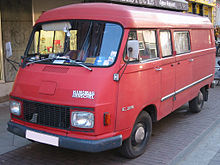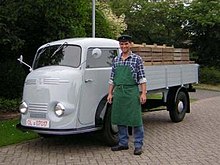Vidal & Sohn Tempo Factory
| Vidal & Sohn Tempo-Werk GmbH
|
|
|---|---|
| legal form | Company with limited liability |
| founding | 1928 |
| Seat | Hamburg - Harburg , Germany |
| Branch | Motor vehicle manufacturer |


- Variants of the Tempo trademark
The Vidal & Sohn Tempo-Werk GmbH , based in Harburg was created in 1928 for vans to build. Due to a law of 1928, motor vehicles with fewer than four wheels and a displacement of less than 200 cubic centimeters could be driven without a license and were tax-free . Therefore there was a great demand for corresponding vehicles.
history
The first Tempo (T1) was created in the father's coal shop, in which Oscar Vidal was involved as a junior partner. There, two master locksmiths built the so-called muzzle loader, a tricycle with the loading area in front of the driver's seat, which was driven by an Ilo motor . The first vehicles manufactured in-house were the T 6 and T 10. The Tempo tricycles and the Matador model are still known today.
The common design principle of the delivery vans was to accommodate everything necessary for the drive in the driver's cab, so that one had a free hand in the choice of the body. The range of special bodies for special transports and municipalities was correspondingly diverse.
From 1933, in addition to the tricycle, which now had a closed driver's cab in front of the loading platform, four-wheeled convertible sedans and delivery vans with box bodies were also manufactured.
Oscar Vidal (Tempo) entered into a connection with Hanomag in 1955 ; In 1959, both companies joined the Rheinstahl group. In 1965 Vidal gave his last shares in the Rheinstahl group, the Tempo brand disappeared. Within the Rheinstahl group, the company came to Hanomag. The Tempo delivery van was further developed into the " Harburger Transporter ", which was initially marketed under the name Hanomag. From 1966 the Tempo Matador also drove with the Rheinstahl-Hanomag emblem. The Tempo plant became part of the new Hanomag-Henschel Fahrzeugwerke GmbH in 1969 , which was taken over by Daimler-Benz AG in 1971 . Since then, today's Daimler group has owned the former Tempo plant. Until 1978, Mercedes continued to build the “Harburger Transporter” with a simplified design (different chassis and rigid axle instead of parallel swing arms at the rear) as the Mercedes L 206/307.
In the mid-1950s, 101,000 three-wheeled “Tempo” vehicles were registered. That number had halved ten years later. In 1978, 3,500 cars were still registered. On December 31, 2008, there were still 87 tricycles from Harburg that were allowed to be used.
Until 1984, the employees of the plant were able to comfortably reach their place of work in Bostelbek on foot from the nearby Tempo-Werk train station of the Niederelbebahn .
Since 1962 Tempo three-wheel vehicles as a joint venture -Product " Bajaj Tempo " in India built (from 1986 Lombardini - diesel engines ) and occasionally imported into Europe. A variant of the Hanseat was produced as a single-cylinder four-stroke diesel until 2000 and was mostly used as an auto rickshaw .
vehicles
The first tricycles
The first Tempo tricycles were created from a combination of motorcycle and flatbed that was in front of the driver. In the further development, the driver's cab was relocated in front of the flatbed or box. The tempo Three wheels were with single or two-cylinder two stroke - combustion engines (e.g. pace A 400 1938 B. 400 cc and 12 hp.) Equipped, which via a gear drives a chain and the front wheel - engine, transmission, the The chain case as a supporting part and the front wheel were articulated to the rest of the vehicle as a whole swiveling part.
Passenger cars
Although the Tempo plant mainly built commercial vehicles, from 1933 there were also some three-wheeled passenger cars. The Tempo Front was offered as a convertible sedan with two seats. There was also a Tempo station wagon , a two-door sedan with four seats. The economic importance of these vehicles, however, remained minor.
Off-road vehicle
The Tempo G 1200 off-road vehicle was produced from 1936 to 1944. Otto Daus developed this off-road vehicle for Tempo in 1936 with two engines (one at the front and one at the rear) and all-wheel drive . The two-stroke engines each had 19 hp and each drove one axle. An engine could be switched off while driving on the road. The Land Rover plant manufactured under license for the newly established Federal Border Police . After the first prototypes in 1952, approx. 278 vehicles were built in two variants between 1953 and 1957 and delivered to the Federal Border Police. The chassis was delivered by Land Rover and equipped by Tempo with an open sheet steel body with a folding top.
Tempo Hanseat and Tempo Boy
After the war, Tempo continued to build the A 400 largely unchanged until March 1950, with a two-cylinder two-stroke engine from Ilo, a non-synchronized three-speed gearbox and cable brakes. The superstructure was supported by a central tubular frame that could be supplied in two sizes, either with a wheelbase of 2870 or 3170 millimeters. With more rounded edges on the bonnet and a new round logo in the radiator grille, the car was called Tempo Hanseat from 1948 . Under pressure from competition from Goliath , the power was increased from 12 to 13 hp in 1950. The front wheel was fitted with a shock absorber and the rigid rear axle, which was suspended from leaf springs, was replaced by a pendulum axle with four coil springs. The payload of the flatbed truck was 750 kg; Price 3300 DM. Other structures such as boxes or cases were available.
Although the trade press certified three-wheeled delivery vans to be useful at speeds of up to 60 km / h, the trend in this class was also towards four-wheeled vehicles. In 1953 the design office Müller-Andernach delivered an improved engine with an output of 15 hp for the Hanseatic League , but this did not increase the meanwhile declining sales figures.
In addition to the Hanseatic company , Tempo has been building the outwardly similar Boy model with a 197 cm³ or optionally 250 cm³ single-cylinder engine since 1950 . Both versions were aimed at the holders of the then Class IV driving license for vehicles up to 250 cm³. The basic price was 2390 DM. With a maximum payload of 420 kg, the Tempo Boy reached a top speed of 40 km / h.
Tempo Matador and Tempo Wiking
At the same time as the Hanseatic League , the Tempo four-wheel delivery vans Matador and Wiking (nickname: "Fischmaul") were added to the program. In contrast to the similar 0.75-ton VW T1 , which was released around the same time , the Matador was a single -ton vehicle and, thanks to its front-wheel drive , offered better use of space and a lower loading height than the VW transporter with a rear-mounted engine; however, it was more expensive at 7100 DM (panel van, 1949). The first matadors from 1949 (the front section of which critics occasionally compared with the face of a boxer dog) were powered by 25 hp VW industrial engines, which the Tempo factory purchased directly from VW. Since Tempo had failed to conclude a long-term supply contract, the general manager of VW, Heinz Nordhoff , was able to stop the delivery of this engine to the competing company at short notice in 1952 . Then the Matador was offered with either a three-cylinder two-stroke engine (672 cm³) or a four-stroke engine (1092 cm³, 34 hp) instead of the four-cylinder boxer engine from VW , both from Ing-Büro Müller in Andernach . In 1953 the Wiking came on the market, a 3/4 tonner (up to 850 kg payload) with a 452 cm³ two-stroke engine (17 hp) from Heinkel , which was built until 1955. Based on the Wiking, the Rapid was an eight-seat minibus that was built from 1957 to 1963. The Rapid was powered by a 948 cc, 25 kW (34 hp) engine supplied by Austin Motor Company and used in the A35 itself . Based on the Matador, there was a sales car , the specialty of which was a lowerable floor, so that the standing height for the salesperson was sufficiently large and contact with the customer at eye level was possible.
Data of the last Tempo Matador before the takeover by Hanomag :
| Tempo Matador 1963/64 | Data |
|---|---|
| Engine: | 4-cylinder in-line engine (Otto) |
| Motor make: | Austin ( British Motor Corporation ) |
| Displacement: | 1593 cc |
| Stroke × bore: | 89 mm × 76 mm |
| Power: | 40 kW (54 PS) at 4000 rpm |
| Max. Torque: | 113 Nm at 2000 rpm |
| Cooling: | water |
| Power transmission: | Front-wheel drive, 4-speed |
| Suspension: | Double wishbone (front), trailing arm (rear) |
| Length × width × height: | 4400 mm × 1700 mm × 2140 mm |
| Wheelbase: | 2400 mm |
| Empty weight: | 1330 kg |
| Payload: | 1550 kg |
| Top speed: | 100 km / h |
| Base price: | 8,875 DM |
The information relates to the version as a panel van.
Models
1928-1943
| Type | Construction period | Quantities |
|---|---|---|
| T 1 | 1928-1930 | 264 |
| T 2 | 1928-1930 | 41 |
| T 6 | 1929-1935 | 3,596 |
| T 10 | 1930-1936 | 840 |
| pony | 1932-1936 | 529 |
| Front 6 | 1933-1935 | 6,100 |
| Front 10 | 1933-1935 | 607 |
| Front 7 (D 200) | 1934-1936 | 1,150 |
| Front 14 (D 400) | 1934-1936 | 2,633 |
| V 600 | 1935-1936 | 823 |
| E 200 | 1936-1937 | 9,600 |
| E 400 | 1936-1937 | 3,311 |
| E 600 | 1936-1937 | 1,947 |
| G 1200 / T 1200 | 1936-1943 | 1,253 |
| A 200 | 1938-1940 | 6,294 |
| A 400 | 1938-1940 | 36,790 |
| A 600 | 1938-1943 | 11,479 |
1949-1966
| Type | Construction period | Quantities |
|---|---|---|
| Matador 49 | 1949-1950 | 99 |
| Hanseatic | 1949-1956 | 37.131 |
| Matador 50 | 1950-1952 | 13,521 |
| boy | 1950-1956 | 5,950 |
| Matador 1000 | 1952-1955 | 4,923 |
| Matador 1400 | 1952-1955 | 5,724 |
| Viking | 1953-1955 | 12,590 |
| Land Rover | 1952-1957 | 278 |
| Matador 56 | 1955-1957 | 1,959 |
| Wiking 1 | 1955-1963 | 16,533 |
| (Wiking) Rapid | 1957-1963 | 21,454 |
| Matador A50 | 1957-1963 | 13,327 |
| Matador 1.5 to. | 1958-1963 | 6,285 |
| Matador E 1.0 to. | 1963-1966 | 21,368 |
| Matador E 1.3 to. | 1963-1966 | 11,743 |
| Matador E 1.6 to. | 1963-1966 | 14,000 |
| Athlete pallet truck | 1965-1966 | 16 |
| Matador E 1.75 to. | 1966 | 182 |
| Matador E 2.5 to. | 1966 | 69 |
| Matador E (all models) | Nov. – Dec. 1966 | 2,009 |
| Athlete pulling head | Dec 1966 | 1 |
New registrations of Tempo cars in the German Reich from 1933 to 1938
| year | Registration numbers |
|---|---|
| 1933 | 26th |
| 1934 | 55 |
| 1935 | |
| 1936 | 36 |
| 1937 | 43 |
| 1938 | 101 |
World records
Five world records in the 200 cm³ class for open delivery vans with a payload of 500 kg were set at one speed on the Berlin AVUS in 1934 . In the 350 cm³ class for three-wheelers, the world records were achieved for 9, 10, 11 and 12 hours and over 1000 kilometers with an average speed of 54.1 km / h.
Web links
source
Matthias Pfannmüller: With speed through time, The tricycles from Vidal & Sohn - From Hamburg to the whole world, Delius Klasing Verlag GmbH, Bielefeld 2006, ISBN 978-3-7688-1729-5
Individual evidence
- ↑ Triumph: History 1896 to 1945 ( Memento of the original from May 7, 2010 in the Internet Archive ) Info: The archive link was inserted automatically and has not yet been checked. Please check the original and archive link according to the instructions and then remove this notice. Introduction of a new driver's license for motorcycles up to 250 cm³ on April 1, 1928
- ↑ Tempo service. Accessed on June 13, 2015. ( Memento of the original from March 29, 2015 in the Internet Archive ) Info: The archive link was inserted automatically and has not yet been checked. Please check the original and archive link according to the instructions and then remove this notice.
- ↑ "Master carpenter from Staufenberg with bride on a DKW motorcycle, around 1930". Historical image documents from Hessen. (As of April 7, 2011). In: Landesgeschichtliches Informationssystem Hessen (LAGIS).
- ↑ www.kba.de/Statistik 2008, page 43 (pdf 2.7 MB) ( Memento from June 12, 2009 in the Internet Archive )
- ^ Werner Oswald : Deutsche Autos 1920-1945 , 10th edition, Motorbuch Verlag Stuttgart (1996), ISBN 3-87943-519-7 , p. 460
- ↑ Tempo G 1200, report in Autobild December 2004 (accessed on June 12, 2010)
- ↑ three-wheeler . In: Automobiltechnische Zeitschrift . 7/1952, pp. 154-157 and 164-165.
- ↑ The new Tempo "Matador" four-wheel delivery van . In: Automobiltechnische Zeitschrift . 6/1949, pp. 147-149.
- ↑ In style: Tempo Matador , DW-TV Motor mobil from October 19, 2011
- ↑ Eight-seat minibus. In: Motor vehicle technology 8/1959, p. 334
- ↑ Sales stand car with a lowerable floor . In: Motor vehicle technology 06/1961, pp. 251-252.
- ^ Hans Christoph von Seherr-Thoss : The German automobile industry. Documentation from 1886 until today . Deutsche Verlags-Anstalt, Stuttgart 1974, ISBN 3-421-02284-4 , p. 328 .














